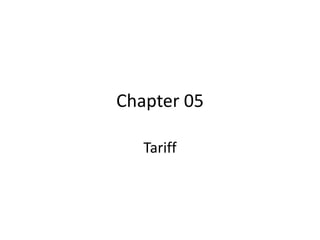
Electricity Tariff Types Explained
- 2. Tariff The rate at which electrical energy is supplied to a consumer is known as tariff.
- 3. Objectives of tariff (i)Recovery of cost of producing electrical energy at the power station. (ii) Recovery of cost on the capital investment in transmission and distribution systems. (iii) Recovery of cost of operation and maintenance of supply of electrical energy e.g., metering equipment, billing etc. (iv) A suitable profit on the capital investment.
- 4. Desirable Characteristics of a Tariff • Proper return • Fairness • Simplicity • Reasonable profit • Attractive
- 5. Types of Tariff Simple tariff When there is a fixed rate per unit of energy consumed, it is called a simple tariff or uniform rate tariff. Disadvantages (i) There is no discrimination between different types of consumers since every consumer has to pay equitably for the fixed charges. (ii) The cost per unit delivered is high. (iii) It does not encourage the use of electricity.
- 6. Flat rate tariff When different types of consumers are charged at different uniform per unit rates, it is called a flat rate tariff. Disadvantages (i) Since the flat rate tariff varies according to the way the supply is used, separate meters are required for lighting load, power load etc. This makes the application of such a tariff expensive and complicated. (ii) A particular class of consumers is charged at the same rate irrespective of the magnitude of energy consumed. However, a big consumer should be charged at a lower rate as in his case the fixed charges per unit are reduced.
- 7. Block rate tariff When a given block of energy is charged at a specified rate and the succeeding blocks of energy are charged at progressively reduced rates, it is called a block rate tariff.
- 8. Two-part tariff When the rate of electrical energy is charged on the basis of maximum demand of the consumer and the units consumed, it is called a two-part tariff. Total charges = Rs (b × kW + c × kWh) where, b = charge per kW of maximum demand c = charge per kWh of energy consumed This type of tariff is mostly applicable to industrial consumers who have appreciable maximum demand
- 9. Advantages (i) It is easily understood by the consumers. (ii) It recovers the fixed charges which depend upon the maximum demand of the consumer but are independent of the units consumed. Disadvantages (i) The consumer has to pay the fixed charges irrespective of the fact whether he has consumed or not consumed the electrical energy. (ii) There is always error in assessing the maximum demand of the consumer.
- 10. Maximum demand tariff. similar to two-part tariff with the only difference that the maximum demand is actually measured by installing maximum demand meter in the premises of the consumer. This removes the objection of two-part tariff where the maximum demand is assessed merely on the basis of the rate able value. This type of tariff is mostly applied to big consumers. However, it is not suitable for a small consumer (e.g., residential consumer) as a separate maximum demand meter is required.
- 11. Power factor tariff The tariff in which power factor of the consumer’s load is taken into consideration is known as power factor tariff • k VA maximum demand tariff • Sliding scale tariff • kW and kVAR tariff
- 12. Three-part tariff When the total charge to be made from the consumer is split into three parts viz., fixed charge, semi-fixed charge and running charge, it is known as a three-part tariff. i.e., Total charge = Rs (a + b × kW + c × kWh) Where, a = fixed charge made during each billing period. It includes interest and depreciation on the cost of secondary distribution and labor cost of collecting revenues, b = charge per kW of maximum demand, c = charge per kWh of energy consumed.
- 13. Example 5.1 A consumer has a maximum demand of 200 kW at 40% load factor. If the tariff is Rs. 100 per kW of maximum demand plus 10 paise per kWh, find the overall cost per kWh.
- 14. Example 5.2 The maximum demand of a consumer is 20 A at 220 V and his total energy consumption is 8760 kWh. If the energy is charged at the rate of 20 paise per unit for 500 hours use of the maximum demand per annum plus 10 paise per unit for additional units, calculate : (i)annual bill (ii) equivalent flat rate.